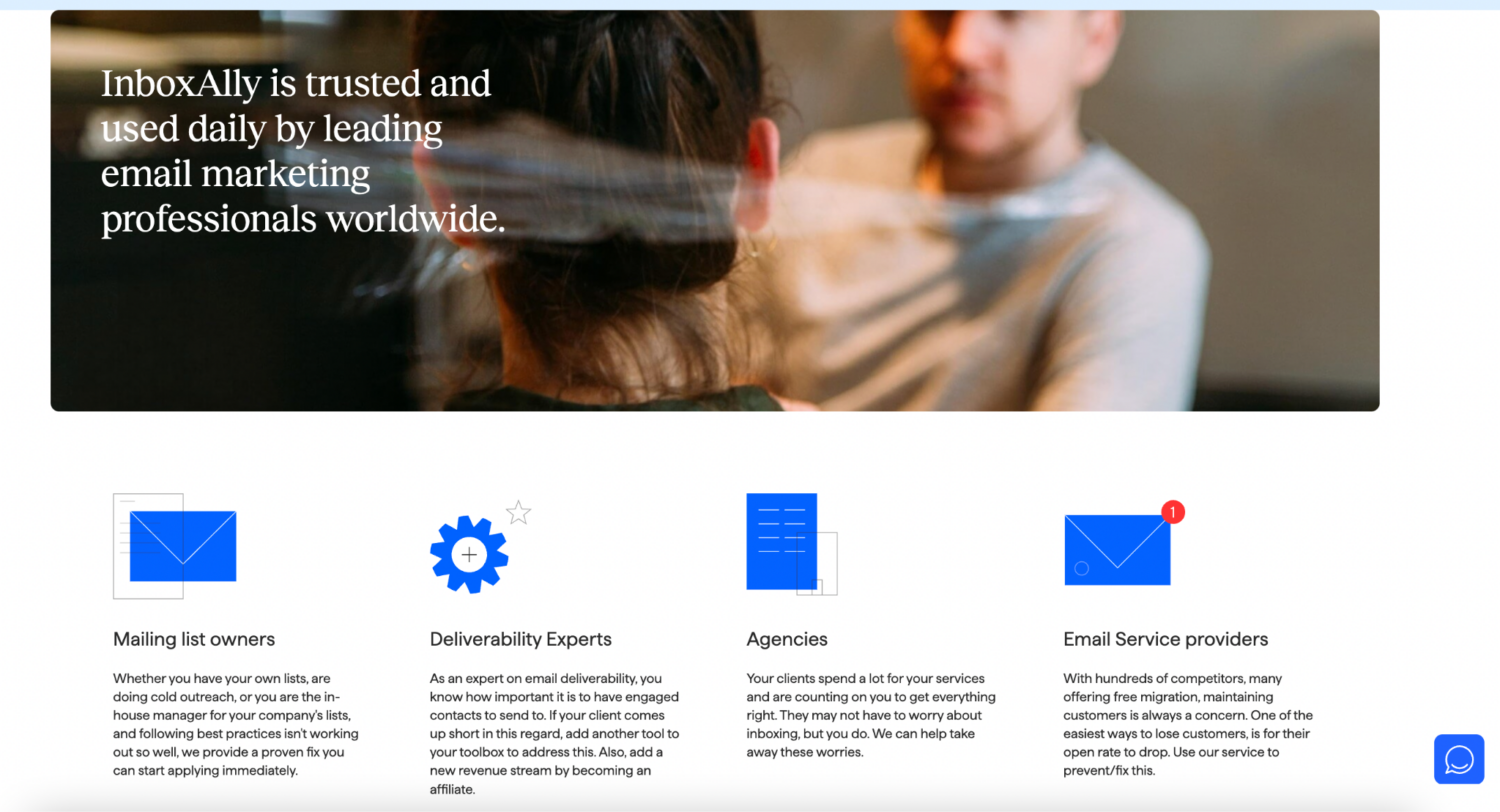In today’s digital age, professionals and businesses use various channels to reach potential clients, customers, or partners. Two popular methods are cold email and LinkedIn. Both approaches also offer unique advantages and can be effective in their own ways.
Cold email involves directly reaching out to individuals via email. It is also less intrusive than cold calling and doesn’t require sales reps. Meanwhile, LinkedIn provides a platform for networking and connecting with professionals in a more targeted manner.
In this article, we will explore the differences between cold email and LinkedIn, highlighting their respective strengths and best practices.
By understanding the nuances of each approach, you can make informed decisions about which method suits your specific goals and maximize your chances of success in your outreach efforts.
Cold Email vs LinkedIn Outreach: 7 Features to Look At
1. Open Rate
The open rate is a critical metric that indicates the effectiveness of your outreach efforts in capturing your recipients’ attention. When comparing cold emails, InMails, and LinkedIn messages, it’s important to understand how they differ in open rates.
Cold emails typically have varying open rates depending on factors such as the quality of the email list, subject line, and email content.
Personalized and targeted cold emails also tend to have higher open rates compared to generic or mass-sent emails. [1]
Read also: Cold Email Open Rates
Meanwhile, LinkedIn messages have a relatively higher open rate than cold emails when sent to relevant connections. Since the messages appear within the LinkedIn platform and are often associated with professional networking, recipients are more inclined to open and engage with them.
InMails, which is LinkedIn’s paid messaging feature, can also have higher open rates compared to both cold emails and regular LinkedIn messages.
This platform bypasses certain LinkedIn connection limitations and often carries more weight and credibility, increasing the likelihood of being opened and read.
Determining which option is better for open rates depends on your target audience and the nature of your outreach.
While cold emails can be effective when properly personalized, LinkedIn messages, particularly InMails, tend to have higher open rates due to the professional context and trusted platform.
2. Response Rate
Response rate is another crucial metric that measures the success of your outreach efforts in generating meaningful engagements. Let’s explore how cold emails, InMails, and LinkedIn messages differ in terms of response rates:
Cold emails typically have lower response rates compared to other forms of outreach. Many of these emails end up in spam folders or go unnoticed due to the high volume of emails people receive.
However, cold emails can still yield favorable response rates. You can employ personalized and targeted approaches and well-crafted follow-up strategies.
Meanwhile, LinkedIn messages generally have higher response rates compared to cold emails. Recipients are likelier to engage and respond since they are sent within the LinkedIn platform. It also often involves professional networking or business-related discussions.
InMails, as paid LinkedIn messages, can have higher response rates compared to both cold emails and regular LinkedIn messages. [2]
The paid nature of InMails adds credibility and increases the chances of receiving a response, especially when reaching out to valuable connections or prospects.
LinkedIn messages (including InMails) are advantageous when considering response rates due to their professional context and the trust associated with the platform.
However, the effectiveness of each option depends on your target audience, the quality of your messaging, and the level of personalization employed.
3. Email Deliverability
Email deliverability plays a crucial role in ensuring that your messages reach recipients’ inboxes rather than being flagged as spam. Let’s examine how cold emails, LinkedIn InMail, and LinkedIn messages differ in terms of deliverability:
Cold emails often face deliverability challenges due to various factors, including spam filters, sender reputation, and the quality of email lists. These are also more likely to be marked as spam, resulting in lower deliverability rates.
However, you can improve deliverability by following email best practices, utilizing reputable email service providers, and ensuring email list quality.
On the other hand, LinkedIn messages generally have good deliverability rates since they are sent within the LinkedIn platform and are less likely to be marked as spam.
However, it’s still important to comply with LinkedIn’s policies and guidelines to maintain a positive sender reputation and ensure optimal deliverability.
InMails often enjoy higher deliverability rates compared to both cold emails and regular LinkedIn messages. As paid messages, InMails are less likely to be flagged as spam and have a higher chance of reaching recipients’ inboxes.
Read also: 11 Email Deliverability Best Practices
4. Email Velocity
Email velocity refers to the frequency or speed at which you send out your outreach messages. Let’s explore how cold emails, InMails, and LinkedIn messages differ in terms of email velocity:
A cold email’s velocity is often subject to limitations imposed by email service providers, anti-spam regulations, and the risk of overwhelming recipients with excessive emails.
Therefore, it’s essential to adhere to email service providers’ guidelines and send only a few emails too quickly. Doing so maintains a good sender reputation and prevents you from being marked as spam.
Meanwhile, LinkedIn imposes its own restrictions on the velocity of regular messages to prevent spamming and maintain a positive user experience.
The specific limitations may vary based on your account type and activity level. So, it’s crucial to be mindful of these restrictions and spread out your outreach efforts over time. Doing so ensures steady and effective messaging without overwhelming recipients.
InMails, on the other hand, often have more flexibility compared to regular LinkedIn messages. While there may still be some limitations, InMails generally allows for more frequent messaging. This, in turn, enables you to reach out to a larger number of valuable connections or prospects within a shorter time frame.
Balancing email velocity is also important to maintain a positive user experience and avoid being flagged as spam. While InMails offer more flexibility in terms of velocity, both cold emails and regular LinkedIn messages require careful pacing and consideration to ensure effective cold outreach.
5. Follow-ups
Effective follow-ups are another crucial feature for maximizing the success of your cold outreach efforts, whether through cold email or LinkedIn messaging.
In a cold email campaign, a follow-up plays a vital role in maintaining engagement and nurturing leads. With email outreach, you can send targeted follow-up messages to prospects who have shown initial interest.
Sending cold email follow-ups allow you to address any unanswered questions, provide additional information, or offer incentives to encourage a response. You can automate these follow-ups using email outreach tools, ensuring consistent and timely communication with your prospects.
LinkedIn messaging also provides an excellent avenue for follow-ups. Following up after sending a LinkedIn message or connection request can reinforce your initial outreach and build rapport.
In addition, a well-crafted follow-up message on LinkedIn can remind recipients of your previous communication. It also offers value or insight related to their professional interests. This personalized approach significantly increases response rates and leads to meaningful conversations.
When deciding between cold email and LinkedIn for follow-ups, consider the preferences of your target audience and the nature of your outreach campaign.
Cold email follow-ups effectively reach prospects more likely to engage through email. Meanwhile, LinkedIn follow-ups are ideal for professionals who prefer communication within the LinkedIn platform.
To optimize your follow-up strategy, leverage the strengths of both cold email and LinkedIn messaging. Combine personalized cold email follow-ups with LinkedIn messages to create a multi-channel approach that maximizes your chances of connecting with prospects.
Tailor your follow-ups based on the recipient’s engagement and interests, utilizing the information available on their LinkedIn profile.
Read also: Cold Email Follow-Up – How to Get Your Prospect to Respond
6. Scale
When it comes to scaling outreach efforts, both cold email and LinkedIn offer unique advantages and considerations.
Cold email provides the ability to reach a large number of prospects simultaneously. With cold email outreach, you can leverage automation tools and personalized templates to engage with a broader target audience efficiently.
In addition, cold emailing allows for scalability by sending mass emails, automating follow-ups, and managing large contact lists. This method is particularly effective for widespread lead generation and broader sales outreach.
On the other hand, LinkedIn offers its own set of advantages for scaling outreach. For instance, you can target specific professionals and companies within your network or industry with LinkedIn messages and connection requests.
LinkedIn automation tools can further streamline the process by automating connection requests and messaging sequences. This approach allows for personalized outreach at scale, making it suitable for targeted lead generation and building working relationships.
The choice between cold email and LinkedIn for scaling outreach depends on various factors. Cold email is ideal for reaching a broader audience, making it a preferred choice for widespread lead-generation efforts. [3]
LinkedIn, on the other hand, offers a more targeted approach, allowing you to focus on specific professionals or companies within your network.
To determine the best approach for scaling, consider your target audience, campaign goals, and available resources.
Cold email is well-suited for high-volume campaigns and a broader reach, while LinkedIn messaging excels at personalized, targeted outreach. A combination of both strategies can also be effective, depending on your specific needs and objectives.
7. Automation
Automation is essential for efficient outreach in both cold email and LinkedIn messaging. A cold email campaign can benefit from email automation platforms and software, allowing for personalized and streamlined communication.
Meanwhile, LinkedIn offers dedicated automation tools for targeted connection requests, messaging, and prospecting.
Balancing automation with personalization ensures effective outreach. Choosing between cold email and LinkedIn automation also varies on campaign goals, target audience preferences, and desired customization.
Therefore, evaluate available tools’ compatibility with your chosen outreach channel and their ability to support a sales team or professionals in achieving their objectives.
Read also: Is it Safe to Use an Automated Email Warmup Service?
8. Ease of Use
Both cold emails and LinkedIn outreach prioritize user-friendly experiences. Cold email software and automation tools simplify campaign management, offering personalization, segmentation, and tracking features.
Meanwhile, LinkedIn’s platform provides an intuitive interface for seamless outreach. With built-in messaging, connection requests, and profile interactions, LinkedIn streamlines the process.
The choice between the two depends on the expertise of your team and the preferences of your target audience. So, consider the familiarity with email marketing tools and the ease of navigating LinkedIn’s platform to determine which option suits your needs best.
9. Cost
When comparing costs, cold emails generally have lower expenses associated with them. For instance, you can choose affordable email service providers and automation tools.
On the other hand, LinkedIn outreach may incur costs if you opt for premium features or specialized automation tools. However, the cost advantage depends on several factors, such as campaign scale and desired personalization.
Cold emails are often more cost-effective for larger-scale outreach. Meanwhile, LinkedIn outreach leverages the vast network of LinkedIn users for targeted connections.
Therefore, consider your budget and resources to make an informed decision about which method aligns best with your lead generation strategy.
10. Data Management
Efficient data management is crucial for maintaining the accuracy and effectiveness of outreach campaigns. Cold email campaigns require effective data management practices, including regular email verification and segmentation.
On the other hand, LinkedIn provides built-in contact management tools, allowing you to organize and track conversations within the platform. In terms of data management, both cold emails and LinkedIn messages have their own considerations.
So, it’s important to implement proper data management practices regardless of the outreach method you choose.
Merge Emails and Linkedin Messages for Better Results
Source: Canva/UnSplash
When it comes to maximizing your outreach efforts and achieving better results, merging emails and LinkedIn messages can be a powerful strategy.
By combining the strengths of cold emails and LinkedIn messages, you can effectively engage with your target audience and enhance your overall outreach strategy.
Cold emails, with their ability to reach a wide range of prospects, provide a scalable approach to connecting with potential leads. They also allow for personalized messaging, tailored content, and the ability to showcase your value proposition.
On the other hand, LinkedIn messages offer a professional and trusted platform, making it easier to establish rapport and build connections.
By merging these two approaches, you can leverage the benefits of both channels. Start by crafting personalized and engaging cold emails, highlighting the key points that resonate with your target audience. [4]
Once you have established initial contact through email, follow up with a LinkedIn message to reinforce your message and establish a professional connection. This combination increases your visibility and credibility while maintaining a personalized touch.
Moreover, you can further enhance your outreach strategy by integrating your cold outreach campaigns with the premium LinkedIn feature, such as InMails and LinkedIn prospecting.
These features also provide access to a larger pool of LinkedIn members, allowing you to reach decision-makers and key stakeholders directly.
However, it’s important to note that while merging emails and LinkedIn messages can be highly effective, avoiding spamming or overwhelming your prospects is crucial.
In addition, maintain a strategic and well-planned approach, ensuring your messages are relevant, personalized, and respectful of your recipients’ preferences.
By integrating cold emails and LinkedIn messages, you can create a comprehensive outreach strategy that utilizes the strengths of both channels. This approach not only improves your chances of connecting with your target audience but also increases the likelihood of generating positive responses and driving conversions.
Improve Your Cold Email Deliverability Rate Using InboxAlly

InboxAlly focuses on improving sender reputation and deliverability for email marketers. When it comes to cold emailing, InboxAlly can play a significant role in enhancing the effectiveness of cold email campaigns.
By training inbox providers to recognize the importance and value of emails sent from your domain, InboxAlly prevents emails from ending in the spam folder. This results in higher open rates and click-through rates, ultimately improving the overall performance of cold email outreach. [5]
In addition, InboxAlly achieves this by utilizing “seed emails,” which engage with the content you send, demonstrating to inbox providers that users find your emails valuable and deserving of inbox placement.
Final Thoughts
Source: Canva/Getty Images
When comparing cold email and LinkedIn as outreach channels, both have their advantages and considerations.
Cold email allows you to reach a broader audience and personalize it for better results. On the other hand, LinkedIn provides a professional context and trusted platform, leading to higher open and response rates.
By combining both strengths through strategic integration, businesses can optimize their outreach efforts and achieve better results in terms of engagement and conversions.
Elevate your cold email game and boost your deliverability rates with InboxAlly – unlock the secret to landing in the primary inbox and start closing deals today. A free live demo awaits you.
References:
[1] https://www.inboxally.com/blog/cold-email-open-rates
[4] https://www.linkedin.com/pulse/emails-vs-linkedin-lead-generation-2021-ing-ilya-nejdanov


